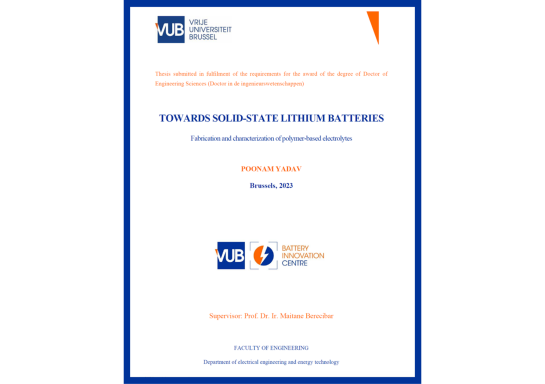
One of the most pressing issues of our time, climate crisis has increased the average global temperature that has profound implications for human lives. Replacing fossil fuels with electricity in transport vehicles is a promising way to reduce carbon emissions, and as energy storage systems, batteries are playing important role towards energy transition. Conventional batteries are approaching their performance limit in terms of energy and power density, therefore, research on new materials is needed to have batteries with improved performance. Solid-state batteries (SSBs) are regarded as favorable future technology as they promise to deliver high energy density, improved safety and enable the use of lithium-metal as anode. However, despite extensive research efforts, the development of SSBs still fall short of expectations mainly because of suitable solid electrolyte which can provide high ionic conductivity as well as good flexibility to enhance interface contact between electrolyte and electrodes.
In the first part of the dissertation, work performed during the IMAGE project is presented, it includes synthesis and characterization of gel polymer electrolyte (GPE), assembly and testing of NMC622/GPE/Li cells at coin cell level. Post-mortem at pouch cell level is conducted to investigate the cause of degradation of the cells.
The second part of doctoral dissertation aims at fabrication of self-standing solid polymer electrolyte (SPE) membranes with good flexibility and mechanical strength. PVDF-HFP is used as the polymer matrix and LiTFSI as lithium salt to fabricate SPE membranes by solution casting method. The electrochemical performance of the fabricated SPE membranes is tested by various testing techniques such as Electrochemical Impedance Spectroscopy (EIS), Linear sweep voltammetry (LSV), DC Polarization, plating/striping test by symmetrical cell (Li/SPE/Li) cycling. Furthermore, LiFePO4 based catholyte is also prepared, and solid-state battery assembly on coin cell level with configuration LiFePO4/SPE/Li was performed. Galvanostatic charge/discharge cycling tests were performed to evaluate the performance of SPE at cell level. A simple and effective hot press rolling technique was shown to improve the electrochemical performance of the SPE by induced structural changes in the grain boundaries of the membrane.
Composite solid polymer electrolytes (CSPEs) membranes are prepared by incorporating LLZTO ceramic filler particles in PVDF-HFP/LiTFSI based SPE slurry. Addition of LLZTO has shown to improve the electrochemical performance and long-term interface stability of CSPE membrane with the lithium-metal anode. Solid-state battery with configuration LiFePO4/CSPE/Li was assembled and tested to evaluate the performance of the CSPE at cell level, which further shows that LiFePO4/CSPE/Li cells provide improved electrochemical performance and capacity retention in comparison to LiFePO4/SPE/Li cells.
